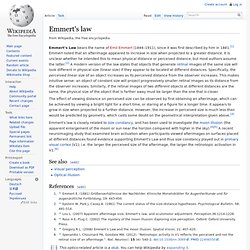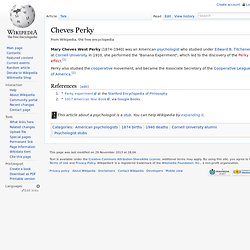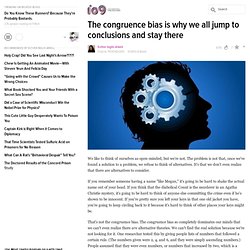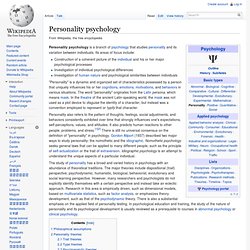

Emmert's law. Emmert's Law bears the name of Emil Emmert (1844–1911), since it was first described by him in 1881.[1] Emmert noted that an afterimage appeared to increase in size when projected to a greater distance.

It is unclear whether he intended this to mean physical distance or perceived distance, but most authors assume the latter.[2] A modern version of the law states that objects that generate retinal images of the same size will look different in physical size (linear size) if they appear to be located at different distances. Specifically, the perceived linear size of an object increases as its perceived distance from the observer increases. This makes intuitive sense: an object of constant size will project progressively smaller retinal images as its distance from the observer increases.
Similarly, if the retinal images of two different objects at different distances are the same, the physical size of the object that is farther away must be larger than the one that is closer. Cheves Perky. Mary Cheves West Perky (1874–1940) was an American psychologist who studied under Edward B.

Titchener at Cornell University. In 1910, she performed the "Banana Experiment", which led to the discovery of the Perky effect.[1] Perky also studied the cooperative movement, and became the Associate Secretary of the Cooperative League of America.[2] How to Win At Rock, Paper, Scissors With Science. A study of common strategies playing Rock, Paper, Scissors has provided advice on the best way to win, at least as long as your opponent has not read the same study.

Rock, Paper, Scissors might once have been a game for children, but these days there are leagues for serious money and even a “world championship”. Meanwhile male lizards have been discovered to be playing the same game. If everyone was random in the way they played the game it would simply be a matter of chance who won. While people will throw away fortunes on games of chance, one with only three options would probably not hold attention. How Does "Valence" Help Your Brain Distinguish Between Good And Bad? Effet Streisand. Un article de Wikipédia, l'encyclopédie libre.

L'effet Streisand est un phénomène médiatique au cours duquel la volonté d’empêcher la divulgation d’informations que l'on aimerait garder cachées — qu'il s'agisse de simples rumeurs ou des faits véridiques — déclenche le résultat inverse. Par ses efforts, la victime encourage malgré elle l'exposition d'une publication qu'elle souhaitait voir ignorée. Il s'agit donc à proprement parler d'un « effet pervers »[1]. Signals Specialist Karin Sigloch Probes the Planet’s Darkest Secrets. Sixty-five million years ago, in the waning days of the dinosaurs, when India was still floating alone near Madagascar, an upwelling of hot rock from deep in the Earth’s mantle called a plume broke through the continent, depositing a 2-kilometer-thick blanket of volcanic material that can still be seen today.

Then India migrated northeastward, eventually slamming into Eurasia. But the plume stayed put. And as the Indian and African plates passed over it, it spawned a chain of volcanic islands that now decorate the floor of the Indian Ocean. Today, that plume sits under Réunion, a French island located east of Madagascar. Gambler's fallacy. The gambler's fallacy, also known as the Monte Carlo fallacy or the fallacy of the maturity of chances, is the mistaken belief that if something happens more frequently than normal during some period, then it will happen less frequently in the future; likewise, if something happens less frequently than normal during some period, then it will happen more frequently in the future (presumably as a means of balancing nature).

In situations where what is being observed is truly random (i.e. independent trials of a random process), this belief, though appealing to the human mind, is false. This fallacy can arise in many practical situations although it is most strongly associated with gambling where such mistakes are common among players. Extract Money From People Using the Ambiguity Effect. Www.rbcpa.com/Mungerspeech_june_95.pdf. Leda Cosmides & John Tooby on Evolution and Emotion. Gerald Clore on Emotion and Cognition.
Roy Baumeister on Self-Regulation and Emotion. Arturo Bejar on Emotion and Social Media. Brian Knutson on Neuroeconomics and Emotion. Jonathan Haidt on Morality and Emotion. A Glossary of Gestures for Critical Discussion. An experiment that tested a man's tolerance for isolation to the limit. I served on US Navy submarines, and although not really isolated from people, we were essentially cut off from society.

Body Atlas Reveals Where We Feel Happiness and Shame. Yellow shows regions of increased sensation while blue areas represent decreased feeling in these composite images.

Image courtesy of Lauri Nummenmaa, Enrico Glerean, Riitta Hari, and Jari Hietanen. Heat maps reveal where you feel emotions in your body. The congruence bias is why we all jump to conclusions and stay there. The whole gateway drug thing is so flawed in so many ways.

One being that though many people who are smack addicts started with pot, there are also many people that only ever smoke pot and never moved to heroin. Personality psychology. Personality psychology is a branch of psychology that studies personality and its variation between individuals.

Its areas of focus include: Construction of a coherent picture of the individual and his or her major psychological processesInvestigation of individual psychological differencesInvestigation of human nature and psychological similarities between individuals. Applied behavior analysis. Applied behavior analysis (ABA), previously known as behavior modification,[1] is the application of operant and classical conditioning that modifies human behaviors, especially as part of a learning or treatment process. Behavior analysts focus on the observable relationship of behavior to the environment, including antecedents and consequences, without resort to "hypothetical constructs".[2] By functionally assessing the relationship between a targeted behavior and the environment, the methods of ABA can be used to change that behavior.
Methods in applied behavior analysis range from validated intensive behavioral interventions—most notably utilized for children with an autism spectrum disorder (ASD)[3]—to basic research which investigates the rules by which humans adapt and maintain behavior. Definition[edit] History[edit] B.F. Why does the placebo effect work?